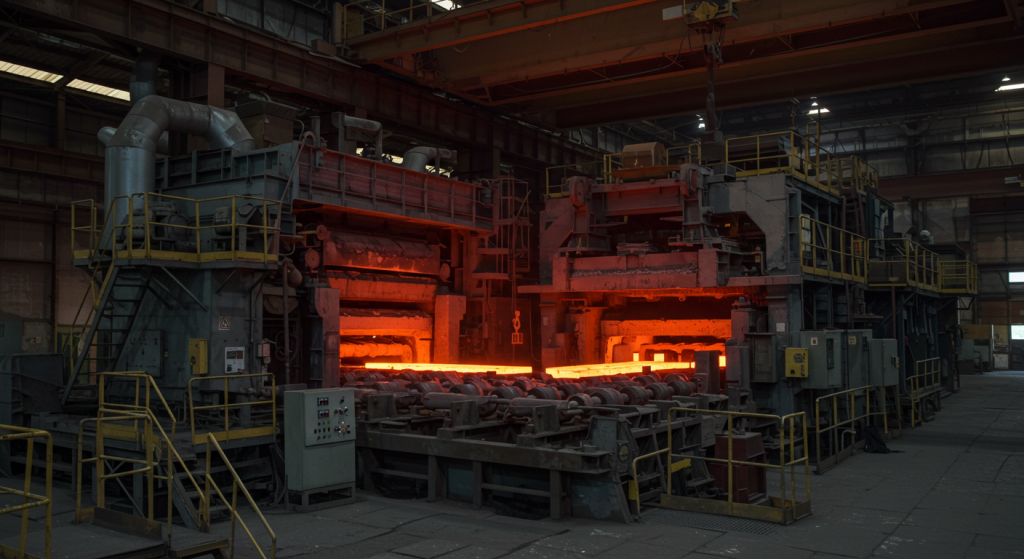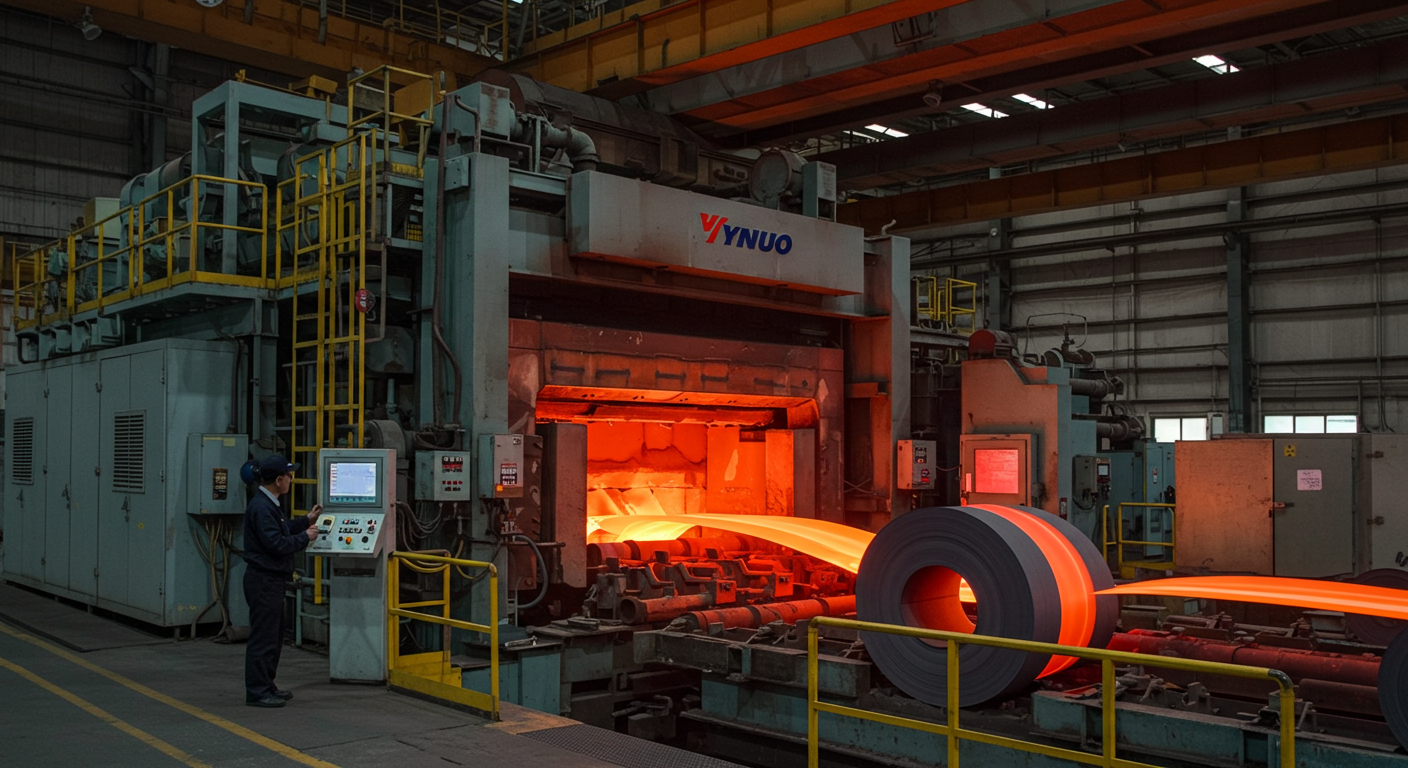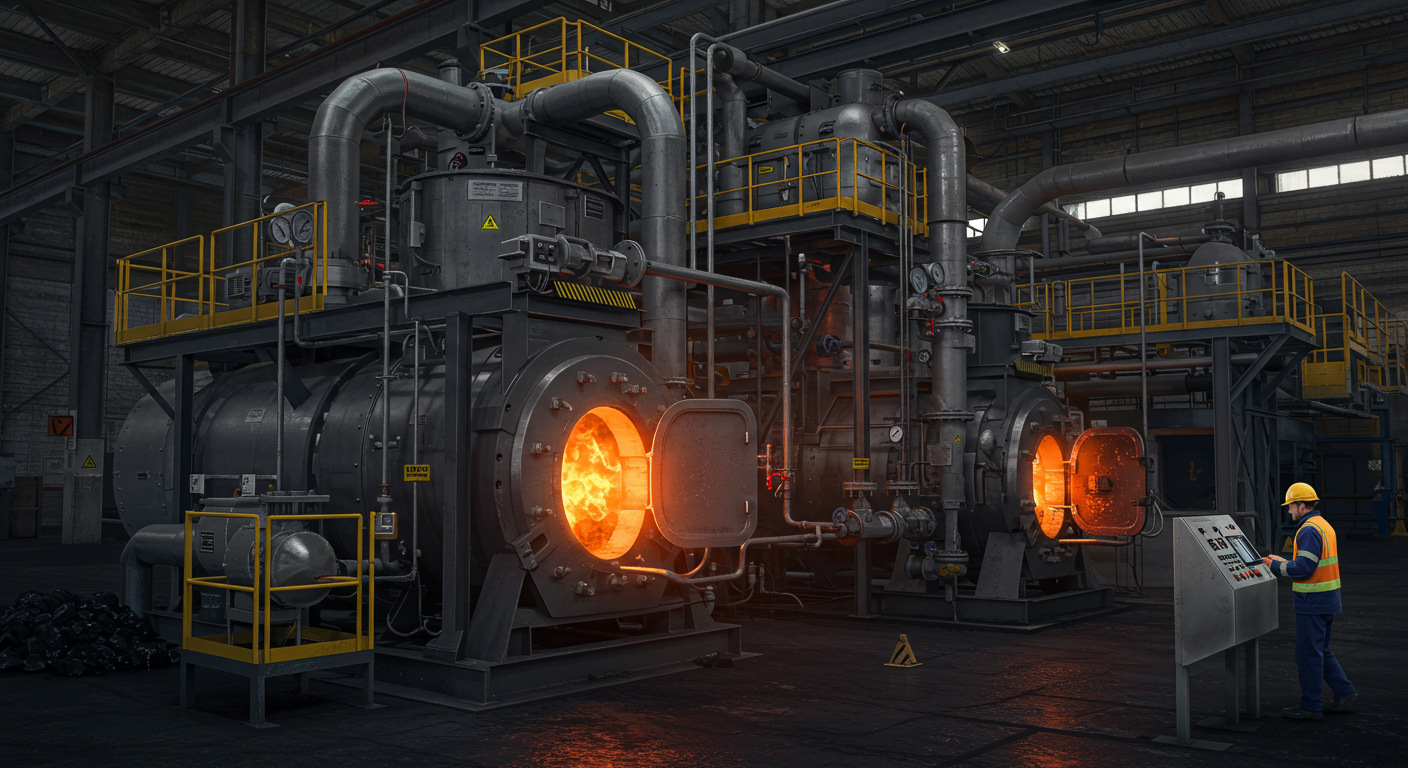
Rolling furnaces play a critical role in metal processing, preheating steel billets, blooms, slabs, or other alloys to precise temperatures for hot rolling into sheets, plates, bars, or rebar. These furnaces ensure uniform heating, enhancing material ductility and enabling high-quality production in industries such as construction, automotive, and infrastructure. Jiangsu Yinuo Thermal Energy Technology Co., Ltd., based in Xuzhou, China, stands as a global leader in manufacturing advanced rolling furnace solutions. This guide explores the technology, applications, and benefits of rolling furnaces, detailing their significance in modern industrial manufacturing, with a focus on efficiency and precision.
What Is Rolling Furnace Technology
Rolling furnaces, often continuous reheating systems, heat metal materials to temperatures typically between 1100°C and 1250°C, preparing them for deformation in rolling mills. The design emphasizes uniform heat distribution, energy efficiency, and compatibility with various metal types, ensuring consistent mechanical properties in the rolled product. Advanced technologies, such as regenerative burners and automated controls, enhance performance, making rolling furnaces indispensable for high-volume metal production.
Core Components
A rolling furnace features a heating chamber lined with refractory materials, such as alumina bricks or ceramic fiber insulation, to withstand extreme temperatures up to 1300°C. Temperature control systems utilize PID controllers or PLC-based automation for precise thermal regulation. Gas-fired burners, often regenerative or radiant tube types, provide efficient heat, while electric heating elements offer cleaner alternatives. Material handling systems, such as pusher mechanisms, walking beams, or roller hearths, convey billets through thermal zones. Atmosphere control systems, using nitrogen or hydrogen blends, prevent oxidation, ensuring surface quality.
Operational Mechanism
Materials enter the furnace via a loading system, typically a pusher or walking beam, advancing through preheating, heating, and soaking zones. The preheating zone gradually raises temperatures to 600–800°C, reducing thermal shock. The heating zone elevates materials to 1100–1250°C, ensuring ductility for rolling. The soaking zone maintains uniform heat penetration, critical for thick slabs or blooms. Conveyance systems move materials to the discharge end, where they exit for rolling. Automated controls monitor temperature, atmosphere, and material flow, optimizing efficiency and repeatability.
Key Applications of Rolling Furnaces
Rolling furnaces serve a broad spectrum of industries, enabling the production of high-quality metal products through precise heat treatment. Their continuous operation and adaptability make them ideal for processing various metal forms, from billets to large slabs.
Steel Production for Construction
In steel production, rolling furnaces preheat billets or slabs for hot rolling into rebar, structural beams, or plates used in construction. Uniform heating ensures consistent microstructure, enhancing strength and ductility for applications like bridges, buildings, and highways. The furnaces’ high throughput supports rolling mills, producing large volumes of steel with minimal defects, meeting the demands of global infrastructure projects.
Automotive Industry
Automotive manufacturing relies on rolling furnaces to preheat steel or aluminum for rolling into sheets or components like body panels and chassis parts. The furnaces’ precise temperature control minimizes scaling, ensuring high surface quality. Multi-zone heating supports complex processes, such as rolling high-strength steels for lightweight vehicles, aligning with the automotive sector’s focus on fuel efficiency and safety.
Infrastructure and Heavy Industry
Rolling furnaces process steel slabs for rolling into heavy plates used in shipbuilding, pipelines, and industrial machinery. The ability to handle large, thick materials ensures robust mechanical properties for demanding applications. Energy-efficient designs, such as regenerative burners, reduce costs in high-volume production, supporting heavy industry’s need for durable, cost-effective materials.
Specialty Metal Processing
For specialty applications, rolling furnaces heat stainless steel, titanium, or copper alloys for rolling into corrosion-resistant or high-performance products. Protective atmospheres prevent oxidation, critical for aerospace or chemical plant components. The furnaces’ flexibility accommodates niche markets, producing precision-rolled sheets or bars with tailored properties, meeting stringent industry standards.
Benefits of Rolling Furnaces
Rolling furnaces offer significant advantages, addressing the needs of industries seeking efficiency, quality, and sustainability. Their advanced technology ensures high performance in demanding manufacturing environments.
Energy Efficiency
Regenerative burner systems recover up to 85–90% of waste heat, preheating combustion air to reduce fuel consumption by 30–50%. Ceramic fiber insulation minimizes heat loss, lowering energy costs. Electric heating options achieve near-100% thermal efficiency, compared to 30–40% for traditional gas systems. These features reduce carbon emissions, aligning with environmental sustainability goals and cutting operational expenses.
Precision and Consistency
Multi-zone temperature control and advanced automation ensure uniform heating, eliminating hot spots and thermal gradients. Atmosphere management systems maintain protective gases, preventing surface defects like scaling. This precision produces consistent mechanical properties, critical for high-quality rolled products used in construction and automotive applications, where reliability is paramount.
High Productivity and Scalability
Continuous operation supports high-throughput production, with furnaces capable of processing billets, slabs, or blooms up to 300 mm thick. Flexible designs accommodate various material sizes and rolling processes, from rebar to thin sheets. Scalability ensures suitability for both large-scale mills and smaller, specialized plants, maximizing operational efficiency.
Table: Key Features of Rolling Furnaces
| Feature | Description |
|---|---|
| Temperature Range | 1100–1250°C, suitable for hot rolling steel, aluminum, and other alloys. |
| Heating Systems | Gas-fired regenerative burners, radiant tubes, or electric elements. |
| Conveyance Systems | Pusher, walking beam, or roller hearth for continuous material movement. |
| Atmosphere Control | Nitrogen, hydrogen, or exothermic gases to prevent oxidation or scaling. |
| Material Capacity | Billets, blooms, slabs up to 300 mm thick, lengths up to 12 meters. |
| Processes Supported | Preheating for hot rolling, forging, extrusion, annealing, normalizing. |
| Energy Efficiency | Regenerative burners, ceramic fiber insulation, up to 50% fuel savings. |
| Automation | PLC-based controls, IoT integration for real-time monitoring and optimization. |
| Applications | Rebar, steel plates, automotive sheets, aerospace alloys, specialty metals. |
| Maintenance | Robust refractories, modular components for minimal downtime and easy repairs. |
Technical Advantages of Rolling Furnaces
Rolling furnaces incorporate advanced features that enhance operational efficiency, product quality, and sustainability, addressing the challenges of industrial metal processing.
Advanced Burner Technology
Regenerative burners cycle between firing and exhaust modes, recovering waste heat to preheat combustion air to 1000–1200°C. Radiant tube burners, used for sensitive materials, provide indirect heating, reducing oxidation. Low-NOx designs minimize emissions, complying with environmental regulations. These burners optimize fuel use, ensuring high thermal efficiency and cost savings in continuous rolling operations.
Robust Conveyance Systems
Pusher, walking beam, or roller hearth systems convey materials smoothly, with heat-resistant rollers or skids handling heavy loads. Walking beams, driven by hydraulic or mechanical systems, ensure precise positioning, ideal for thick slabs. Roller hearths, with individually driven rollers, offer flexibility for variable speeds and long products, minimizing downtime and enhancing productivity.
Automation and Control
PLC-based control systems with IoT integration enable real-time monitoring, temperature adjustments, and predictive maintenance. Automated loading/unloading and material tracking streamline operations, reducing labor costs. Multi-zone heating with independent controls ensures precise thermal profiles, supporting complex processes like rolling high-strength steels or specialty alloys, critical for modern manufacturing.
Industry-Specific Considerations
Different industries require tailored rolling furnace configurations to meet specific process and material demands. Understanding these requirements ensures optimal performance and cost efficiency.
Steel and Construction
Steel applications prioritize high capacity, with furnaces up to 6 meters wide handling billets or slabs for rebar and structural plates. Gas-fired regenerative burners are common, offering cost-effective heating for continuous rolling mills. Robust conveyance systems and quenching options support processes like normalizing, ensuring steel meets construction standards.
Automotive and High-Strength Steels
Automotive applications require precision for rolling high-strength steels or aluminum sheets. Furnaces with tight temperature tolerances (±5°C) and protective atmospheres ensure surface quality. Rapid transfer to cooling systems minimizes distortion, critical for lightweight vehicle components. Automation enhances efficiency in high-volume production.
Aerospace and Specialty Alloys
Aerospace demands furnaces for stainless steel or titanium alloys, requiring protective atmospheres and precise thermal cycles. Smaller furnace widths (2–4 meters) suit compact components, with rapid quenching for solution heat treatment. Compliance with aerospace standards, such as AMS 2750, is ensured through advanced controls and documentation.
Non-Ferrous Metal Processing
Non-ferrous applications, like aluminum or copper rolling, use furnaces with hydrogen atmospheres to prevent oxidation. Radiant tube heating and ceramic-lined rollers ensure clean surfaces, critical for electrical or consumer goods. Energy-efficient designs reduce costs in high-value material processing.
Challenges and Solutions
Rolling furnaces face challenges like energy loss, material defects, and maintenance demands, but advanced engineering addresses these issues effectively.
Energy Loss and Efficiency
Heat loss through furnace walls and exhaust gases is a concern. Regenerative burners and ceramic fiber insulation reduce losses by up to 50%. CFD simulations optimize furnace design, minimizing external wall temperatures. Electric heating options further enhance efficiency, particularly for smaller furnaces.
Material Defects and Quality
Thermal gradients or scaling can cause defects. Multi-zone temperature control and protective atmospheres, such as nitrogen-hydrogen blends, ensure uniform heating and clean surfaces. Automated atmosphere monitoring prevents air ingress, critical for high-quality steel or aluminum rolling.
Maintenance and Downtime
Heavy loads and high temperatures stress conveyance systems and refractories. Robust rollers, made of nickel-chromium alloys, and modular refractory designs extend lifespan. Spare parts bundling and predictive maintenance via IoT reduce downtime, ensuring continuous operation.
Future Trends in Rolling Furnaces
The rolling furnace industry is evolving, driven by advancements in automation, sustainability, and material processing, shaping the future of industrial heating.
Automation and Smart Technology
AI-driven controls and IoT integration enable real-time optimization, predictive maintenance, and material tracking. Automated systems reduce labor costs and enhance precision, supporting complex rolling processes for advanced alloys. These innovations drive productivity in high-volume manufacturing.
Sustainability Initiatives
Electric furnaces and renewable energy integration lower carbon emissions, aligning with environmental regulations. Ultra-low NOx regenerative burners and advanced insulation further reduce environmental impact. These trends support sustainable metal processing, meeting global demand for greener production.
Advanced Material Processing
Demand for furnaces supporting high-strength steels, aluminum alloys, and additive-manufactured components is rising. Rolling furnaces are adapting to process materials like 22MnB5 steel for hot forming, requiring precise thermal cycles. This supports innovation in automotive and aerospace sectors.
Choosing the Right Rolling Furnace
Selecting a rolling furnace requires evaluating process, material, and production needs to ensure optimal performance and cost efficiency.
Key Factors to Consider
Material type, such as carbon steel or titanium, determines furnace configuration and atmosphere requirements. Process needs—hot rolling, forging, or extrusion—dictate temperature range and conveyance system. Production scale influences furnace size, with high-throughput mills needing wider designs. Energy efficiency, driven by regenerative burners or electric systems, impacts costs. Automation and maintenance support ensure reliability.
Partnering with Jiangsu Yinuo
Jiangsu Yinuo’s team provides expert guidance, designing custom furnaces tailored to specific industrial goals. Installation and ongoing support ensure seamless performance, delivering precision and efficiency. Clients can explore solutions and connect through the Jiangsu Yinuo website for tailored furnace options, backed by global expertise.
Frequently Asked Questions
What is the purpose of a rolling furnace?
Rolling furnaces preheat steel or alloys for hot rolling, ensuring ductility for sheets, plates, or rebar production.
What materials can rolling furnaces process?
Steel, aluminum, stainless steel, titanium, and copper alloys are processed, supporting construction, automotive, and aerospace.
How is furnace quality ensured?
Production involves rigorous testing of components, using premium refractories, with compliance documentation meeting ISO and CE standards.
Are rolling furnaces customizable?
Furnaces are tailored to specific material, process, and production needs, with support from design to installation.
How energy-efficient are rolling furnaces?
Regenerative burners and insulation reduce fuel use by up to 50%, lowering costs and emissions.
How can a quote be requested from Jiangsu Yinuo?
A contact form, email, or phone inquiry through the Jiangsu Yinuo website provides a prompt response.
Conclusion: Advancing Metal Processing with Rolling Furnaces
Rolling furnaces deliver precision, efficiency, and sustainability, driving high-quality production in steel, automotive, and infrastructure industries. Jiangsu Yinuo Thermal Energy Technology Co., Ltd. offers innovative, customized solutions that empower manufacturers globally. With advanced technology and a focus on performance, these furnaces meet the demands of modern metal processing. Explore offerings and connect through the website for a personalized quote to enhance production capabilities today.







